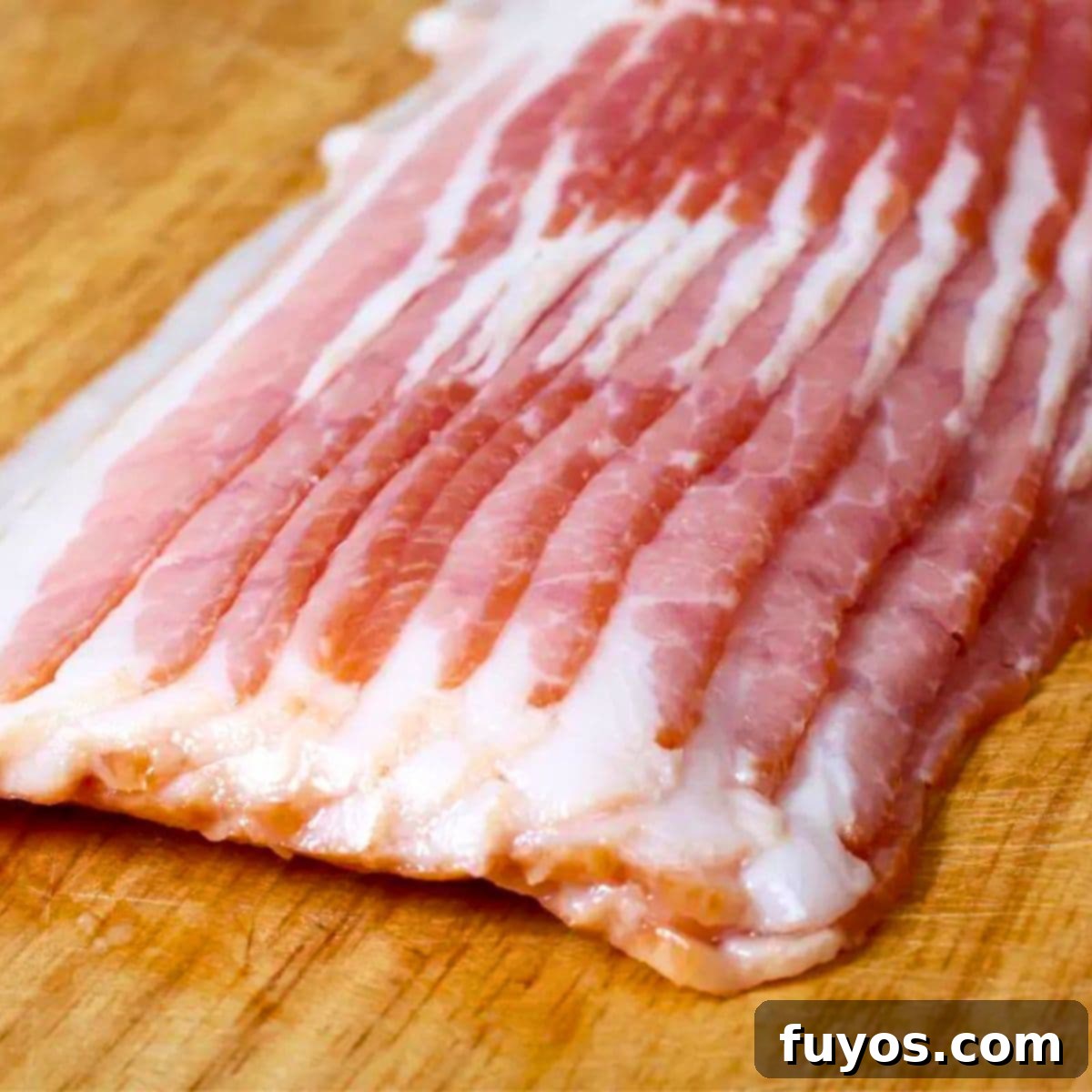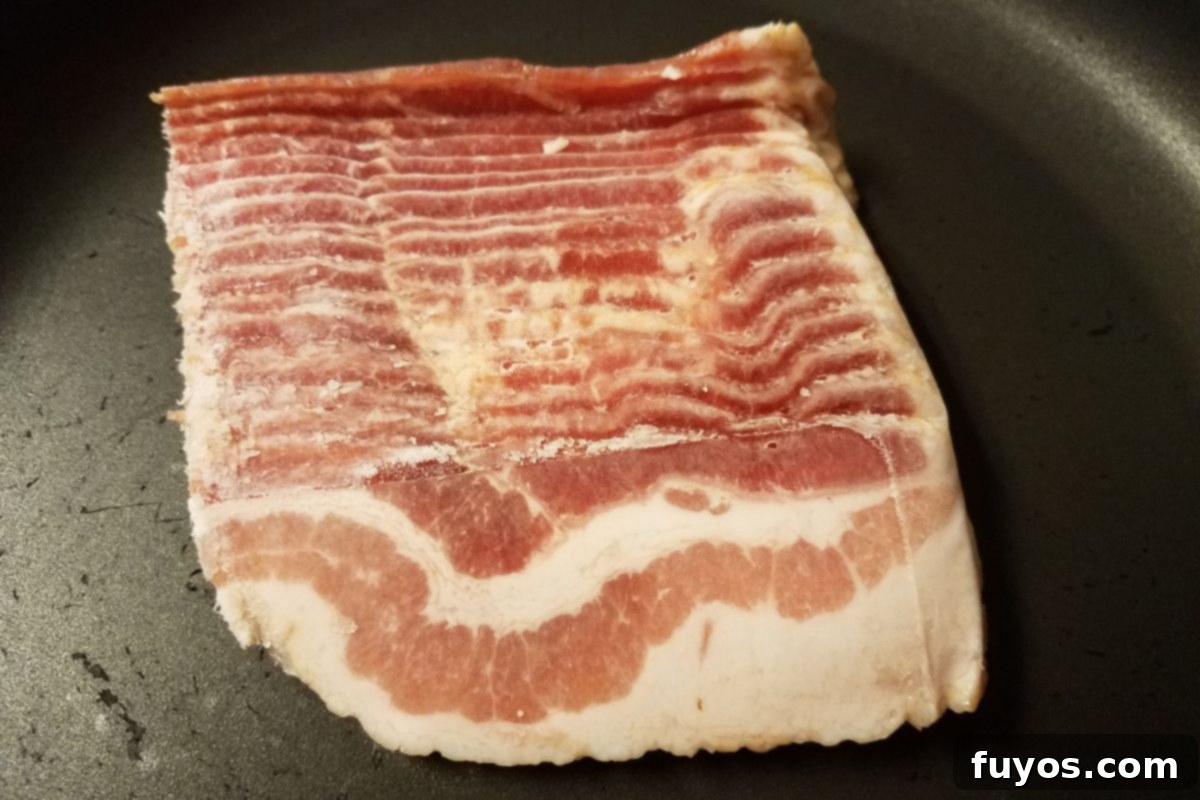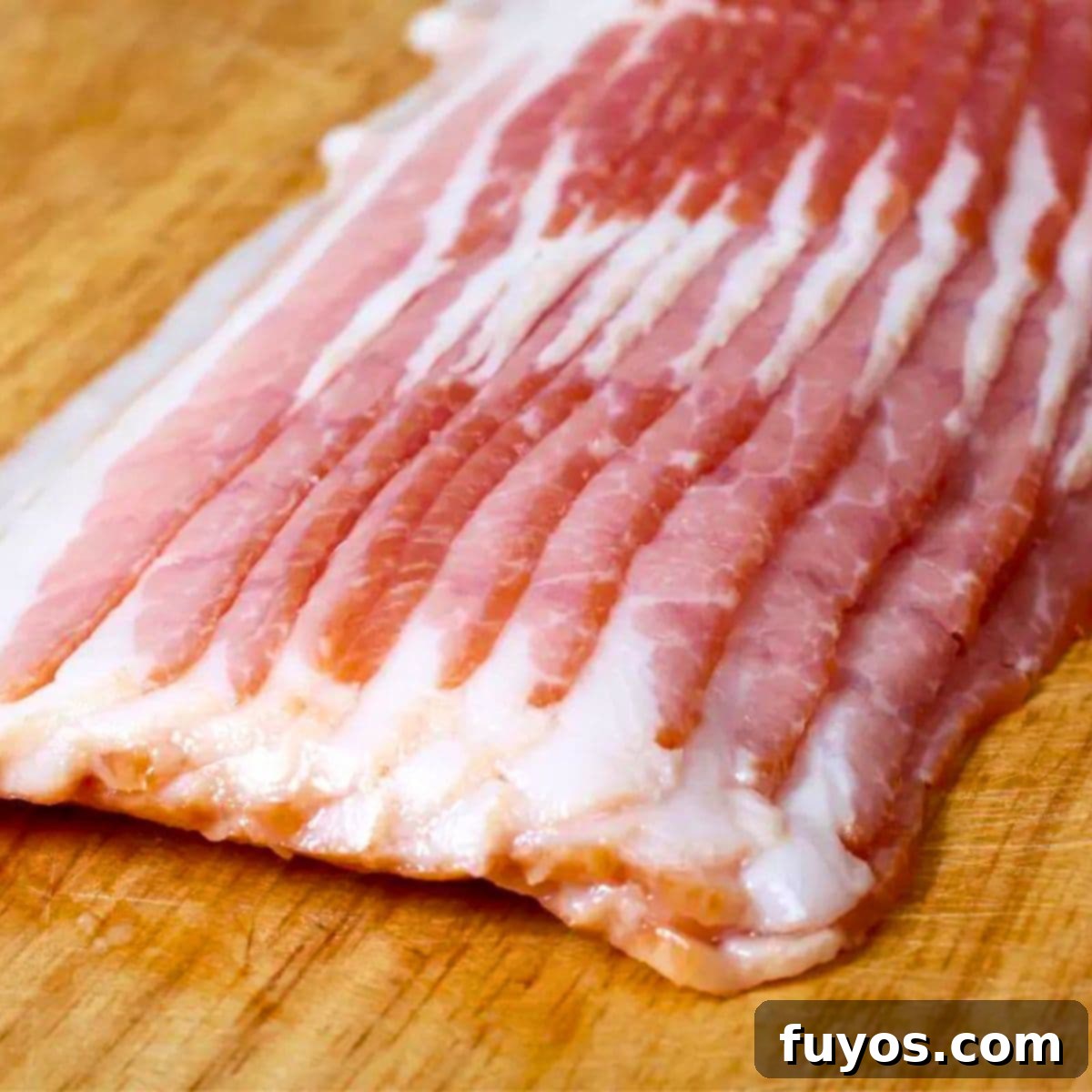The Ultimate Guide: How to Quickly & Safely Defrost Bacon in a Microwave
Bacon, that irresistible crispy, savory delight, holds a special place in the hearts of breakfast lovers across America and indeed, the world. Its versatility extends far beyond the breakfast plate, gracing lunch sandwiches, dinner dishes, and even desserts with its unique smoky flavor. Whether you’re making a classic bacon sarnie, adding a meaty crunch to a salad, or topping off a burger, bacon always elevates the meal.
However, like many fresh meats, bacon has a limited shelf life. To prolong its freshness and ensure you always have some on hand for those sudden cravings, freezing is an excellent solution. The only catch? When that craving hits, you’re often faced with a solid block of frozen bacon, leaving you wondering how to quickly and safely get it ready for cooking.

Trying to cook bacon straight from the freezer is a recipe for disaster—it cooks unevenly, can be tough, and generally doesn’t deliver that perfect crispy texture. This is where defrosting comes in, and thankfully, there’s a surprisingly fast and easy method that can save your breakfast (or any meal): your microwave!
In this comprehensive guide, we’ll walk you through the quickest and most efficient way to defrost bacon using your microwave, ensuring it’s perfectly thawed and ready for your pan in minutes. We’ll also cover crucial safety tips and explore other effective defrosting methods, so you’re never caught off guard when a bacon craving strikes.
Let’s dive in and transform that icy block into delicious, cook-ready bacon!
Quick + Easy Recipes
straight to your inbox
Is It Safe To Defrost Bacon In A Microwave?
Absolutely, defrosting bacon in the microwave is not only safe but also one of the most effective methods, provided you follow a few simple guidelines. Microwaves excel at rapidly distributing heat, allowing frozen foods to thaw evenly and efficiently. This significantly reduces the time food spends in the “danger zone”—temperatures between 40°F (4°C) and 140°F (60°C) where harmful bacteria can multiply rapidly. By quickly moving your bacon from frozen to thawed, you minimize these risks.
Using a microwave to defrost bacon can slash your preparation time from hours (for fridge thawing) to mere minutes. This speed is invaluable when you’re in a rush to whip up a delicious meal like eggs, bacon, and toast, or a gourmet bacon grilled cheese, both of which pair perfectly with perfectly defrosted bacon and are often featured in our best Gourmia air fryer recipes!
To ensure a safe and successful defrosting process, keep the following critical factors in mind:
- Avoid Overheating: The goal is to defrost, not cook. Overheating can cause the bacon to start cooking, leading to tough, rubbery spots and potentially uneven thawing in other areas. This is particularly important for thinner slices.
- Prevent Underheating: Conversely, underheating leaves parts of the bacon still frozen, making it difficult to separate and cook properly. It can also prolong the total thawing time.
- Understand Your Microwave’s Wattage and Settings: Microwave power varies significantly. A higher wattage microwave will defrost faster. Familiarize yourself with your appliance’s defrost settings (often a percentage of full power) or its specific “Defrost” button, which typically cycles power to prevent cooking.
- Never Use Aluminum Foil or Metal: This is a crucial safety warning. Metal, including aluminum foil, should never be placed inside a working microwave. It can cause dangerous arcing, spark, and even damage your appliance or start a fire. Always remove bacon from its original foil packaging if applicable, or any metal ties, before microwaving.
- Cook Immediately: Always cook bacon immediately after defrosting in the microwave. Unlike refrigerator thawing, microwave thawing brings parts of the food to temperatures where bacteria can grow. Cooking it right away ensures any potential bacteria are killed.
How To Defrost Bacon In A Microwave: Step-by-Step

Follow these 4 simple steps to safely and effectively defrost your bacon in the microwave. Precision in each step will ensure the best results.
Step 1: Wrap It Up
Once you retrieve your bacon from the freezer, carefully remove it from its original packaging. This is crucial as original packaging might contain foil or materials not safe for microwave use, and it also allows for better moisture management. Next, grab several sheets of paper towels. Individually wrap each strip of bacon (or small, easily separable sections) with the paper towels. These towels serve a dual purpose: they absorb any excess moisture or fat that may render during the defrosting process, preventing messy splatters inside your microwave, and they help promote more even thawing by insulating the bacon slightly.
Step 2: Spread It Out
Arrange the paper towel-wrapped bacon strips onto a microwave-safe plate. The key here is to ensure that none of the pieces are overlapping. A single layer is essential for uniform defrosting, allowing the microwave energy to reach each piece equally. If your bacon has frozen into a solid, unyielding block, you might need a preliminary step. Briefly run the frozen block under cool tap water for a minute or two, or let it sit at room temperature for about 5 minutes. This slight softening should allow you to gently pry the individual strips apart, making them ready for proper microwave defrosting.
Step 3: Set Up The Microwave
Before you begin, consult your microwave’s manual to understand its specific defrosting functions and recommended settings. Many modern microwaves feature a dedicated “Defrost” setting, often categorized by food type (e.g., “Meat,” “Poultry”) or by weight. This setting typically uses pulsed, lower power levels to gently thaw food without cooking it. If your microwave lacks a specific defrost button, you can achieve a similar effect by setting it to a low power level, usually 30% to 50% power, for shorter intervals. For a standard microwave, a good starting point for a pound of bacon is around 2-3 minutes on the defrost setting, or 1-2 minutes on 50% power. Remember, the goal is to thaw, not cook, so lower power and shorter bursts are key.
Step 4: Put The Bacon In The Microwave
Place the plate with the prepared bacon into the microwave. Start the defrost cycle. It is crucial to stay close and monitor the bacon closely. Don’t just set it and forget it. After about 1-2 minutes (or halfway through your initial estimate), pause the microwave. Check the bacon, carefully flipping the strips and rearranging them to ensure even thawing. Gently try to separate any pieces that might still be sticking together. Look for signs of cooking, such as the bacon turning a lighter pink, becoming opaque, or starting to sizzle. If you notice these signs, immediately remove the bacon, as it’s beginning to cook rather than just defrost. Continue defrosting in short 30-second to 1-minute intervals, checking and rotating until all pieces are pliable and fully thawed. The total time will vary based on the quantity, thickness, and your microwave’s wattage.
Other Ways To Defrost Bacon
While the microwave offers the quickest route to defrosted bacon, it’s not the only method. If you don’t have a microwave, or simply prefer an alternative, these techniques are also effective, though some require more time or preparation.
Defrosting In The Fridge (The Safest, But Slowest Method)
This is by far the safest method for defrosting any meat, including bacon, but it requires foresight. Simply remove the frozen bacon from the freezer, place it in its original packaging (or a sealed bag to prevent drips) on a plate or in a shallow dish, and transfer it to your refrigerator. Leave it there overnight, or for at least 24 hours for every pound of bacon. The slow, consistent cold environment ensures the bacon thaws safely below the bacterial danger zone. Once thawed in the fridge, bacon can typically remain safe for an additional 3-5 days before cooking, making it ideal for meal planning.
Defrosting In An Oven (For Partial Thawing or Cooking from Frozen)
Using an oven is less about pure defrosting and more about partially thawing or even cooking bacon straight from frozen. If your goal is just to thaw, the oven isn’t the most efficient. However, if you plan to cook the bacon immediately, you can achieve good results. Preheat your oven to a low temperature, around 300°F (150°C), and arrange the frozen bacon strips on a baking sheet lined with parchment paper, ensuring they don’t overlap. Place in the oven for about 5-10 minutes. At this point, the bacon will likely be pliable enough to separate. You can then increase the temperature to your desired cooking level (typically 375-400°F or 190-200°C) and continue cooking until crispy, or transfer it to a pan for frying. It’s a good method if you’re already using the oven for something else.
Using a Cold Water Bath (The Medium-Speed Method)
This method offers a good compromise between speed and safety, especially if you have a solid block of frozen bacon. First, ensure your bacon is in a leak-proof plastic bag or its original vacuum-sealed packaging. Submerge the sealed bag of bacon in a bowl of cold tap water. The key is to use *cold* water, not warm or hot, to keep the bacon out of the bacterial danger zone. The circulating cold water will conduct heat to the bacon, thawing it relatively quickly. For faster thawing, change the water every 30 minutes. A pound of bacon can defrost in a cold water bath in about 30 minutes to an hour. Always cook bacon immediately after thawing with this method.
Running Cold Water Over (For Separation)
If your bacon is frozen solid in a clump and you just need to separate the strips for microwave or pan frying, briefly running cold water over the block can help. Place the frozen bacon in a colander and let cold tap water run over it for a minute or two. This will slightly soften the outer layers, making it easier to gently pry the individual pieces apart. Once separated, you can proceed with one of the other defrosting methods or cook them immediately if they are mostly thawed.
Tips for Freezing Bacon Properly
Proper preparation before freezing can make the defrosting process much easier:
- Portion Before Freezing: If you buy large packs of bacon, consider dividing them into smaller, meal-sized portions before freezing. This way, you only defrost what you need, reducing waste and speeding up thawing.
- Prevent Sticking: Lay individual bacon strips flat on a baking sheet lined with parchment paper and freeze for about 30 minutes until firm. Then, stack the semi-frozen strips with parchment paper between layers into an airtight freezer bag or container. This “flash freezing” prevents them from sticking together, allowing you to easily pull out individual slices later.
- Airtight Packaging: Always use freezer-safe bags or containers that are airtight. Vacuum-sealing is ideal. This prevents freezer burn, which can affect the bacon’s texture and flavor.
- Label and Date: Clearly label your packages with the date of freezing. Bacon typically maintains its best quality in the freezer for about 1-2 months, though it can remain safe to eat for much longer.
What to Do After Defrosting Bacon
Once your bacon is thoroughly defrosted, it’s crucial to handle it correctly to ensure food safety and optimal taste:
- Cook Immediately: For bacon defrosted using the microwave or cold water bath methods, it is imperative to cook it immediately. These rapid thawing methods can bring the bacon to temperatures where bacteria can multiply, so cooking without delay is key to safety.
- Do Not Refreeze: Never refreeze bacon that has been thawed in the microwave or a cold water bath. The rapid temperature changes can degrade the meat’s quality and increase bacterial risk. Bacon thawed in the refrigerator is the only exception, as it remains at a consistently safe temperature.
- Choose Your Cooking Method: Once defrosted, your bacon is ready for any cooking method you prefer:
- Pan-Frying: The classic method for crispy strips.
- Oven Baking: Great for cooking large batches evenly with minimal splatter.
- Air Frying: A quick way to achieve extra crispy bacon with less fat.
Final Thoughts
In summary, successfully defrosting bacon in a microwave is a practical and time-saving solution, especially when you need that delicious, smoky flavor in a pinch. When performed correctly, allowing approximately 5 minutes per pound on a defrost setting, you can achieve perfectly thawed bacon ready for cooking.
The results will be significantly better, and the bacon will defrost more rapidly and evenly if the slices are separated before being put into the microwave. If they’re frozen solid, a brief rinse under cold water can help you achieve this separation. Always remember to monitor closely, flip the bacon, and remove any metal packaging to ensure a safe process.
While other methods like refrigerator thawing or a cold water bath are viable, the microwave stands out for its speed and convenience. Whatever technique you choose to get your bacon ready, mastering the defrosting process is the first step to enjoying consistently delicious bacon.
katie’s tip
Did you know you can also cook turkey bacon in the microwave for a time-saving, low calorie version of the classic?
We hope you found this article helpful in making your bacon preparation easier and safer!
